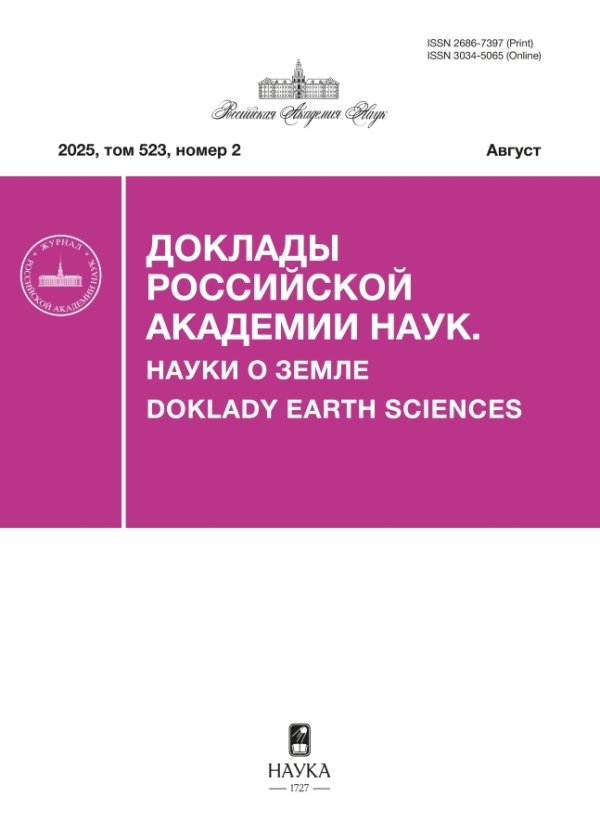Моделирование термоконвективной эволюции земного ядра
- Авторы: Аранович Л.Я.1, Котелкин В.Д.2
-
Учреждения:
- Институт геологии рудных месторождений, петрографии, минералогии и геохимии Российской Академии наук
- Московский государственный университет им. М.В. Ломоносова
- Выпуск: Том 520, № 1 (2025)
- Страницы: 167-174
- Раздел: ФИЗИКА ЗЕМЛИ
- Статья получена: 03.06.2025
- Статья опубликована: 30.05.2025
- URL: https://gynecology.orscience.ru/2686-7397/article/view/682419
- DOI: https://doi.org/10.31857/S2686739725010197
- EDN: https://elibrary.ru/GVBVVA
- ID: 682419
Цитировать
Полный текст
Аннотация
Проведено 2D-моделирование чисто термической конвекции в жидком ядре Земли, происходящей на фоне остывания планеты. Модель включает систему уравнений термической конвекции в приближении Буссинеска с учётом силы Кориолиса, обусловленной вращением Земли. В качестве вещества ядра принято металлическое железо с добавкой 0.9 масс. % Н. Результаты расчётов показали, что в жидком внешнем ядре ещё до начала кристаллизации внутреннего ядра формируются крупные вихри, являющиеся двумерными аналогами вихревых столбов Тейлора, с образованием которых связывается генерация магнитного поля. Начальные стадии кристаллизации характеризуются быстрым хаотичным ростом и бесформенной конфигурацией твёрдого ядра. По мере роста твёрдого ядра начинается перестройка структуры конвекции, её средняя скорость уменьшается. Но тепловой поток из ядра в мантию при этом увеличивается из-за выделения тепла кристаллизации. Внутреннее ядро достигает современного размера за 0.5 млрд лет. Усреднённый профиль температуры в современном жидком ядре отличается от адиабатического.
Ключевые слова
Полный текст
Об авторах
Л. Я. Аранович
Институт геологии рудных месторождений, петрографии, минералогии и геохимии Российской Академии наук
Автор, ответственный за переписку.
Email: lyaranov@igem.ru
Академик РАН
Россия, МоскваВ. Д. Котелкин
Московский государственный университет им. М.В. Ломоносова
Email: vyacheslav.kotelkin@math.msu.ru
Россия, Москва
Список литературы
- Aubert J. State and evolution of the geodynamo from numerical models reaching the physical conditions of Earth’s core // Geophysical Journal International. 2023. V. 235. P. 468–487. https://doi.org/10.1093/gji/ggad229
- Biggin A., Piispa E., Pesonen L. et al. Palaeomagnetic field intensity variations suggest Mesoproterozoic inner-core nucleation // Nature. 2015. V. 526. P. 245–248. https://doi.org/10.1038/nature15523
- Bono R. K., Tarduno J. A., Nimmo F., Cottrell R. D. Young inner core inferred from Ediacaran ultra-low geomagnetic field intensity // Nature Geoscience. 2019. V. 12. P. 143–147. https://doi.org/10.1038/s41561-018-0288-0
- Bouffard M., Choblet G., Labrosse S., Wicht J. Chemical Convection and Stratification in the Earth’s Outer Core // Frontiers in Earth Science. 2019. V. 7: 99. https://doi.org/10.3389/feart.2019.00099
- Braginsky S. Structure of the F layer and reasons for convection in the Earth’s core // Soviet Physics Doklady. 1963. V. 149. P. 8–10.
- Davies C. J., Greenwood S. Dynamics in Earth's Core Arising from Thermo-Chemical Interactions with the Mantle. In: Core‐Mantle Co‐Evolution: An Interdisciplinary Approach. T. Nakagawa, T. Tsuchiya, M. Satish-Kumar, G. Helffrich (Eds.). 2023. https://doi.org/10.1002/9781119526919.ch12
- Deschamps F., Cobden L. Estimating core-mantle boundary temperature from seismic shear velocity and attenuation // Frontiers in Earth Science. 2022. V. 10: 1031507. https://doi.org/10.3389/feart.2022.1031507
- Dziewonski A. M., Anderson D. L. Preliminary reference Earth model // Physics of the Earth and Planetary Interior. 1981. V. 25. P. 297–356. https://doi.org/10.17611/DP/9991844
- Жарков В. Н. Физика земных недр. М.: Наука и образование, 2012. 383 с.
- Hirose K., Tagawa S., Kuwayama Y. et al. Hydrogen limits carbon in liquid iron // Geophysical Research Letters. 2019. V. 46. P. 5190–5197. https://doi.org/10.1029/2019GL082591
- Konôpková Z., McWilliams R. S., Gómez-Pérez N., Goncharov A. F. Direct measurement of thermal conductivity in solid iron at planetary core conditions // Nature. 2016. V. 534. P. 99–101. https://doi.org/10.1038/nature18009
- Sakamaki K., Takahashi E., Nakajima Y. et al. Melting phase relation of FeHx up to 20 GPa: Implication for the temperature of the Earth’s core // Physics of the Earth and Planetary Interior. 2009. V. 174. P. 192–201. https://doi.org/10.1016/j.pepi.2008.05.017
- Zhang D., Jackson J. M., Zhao J. et al. Temperature of Earth's core constrained from melting of Fe and Fe0.9Ni0.1 at high pressures // Earth and Planetary Science Letters. 2016. V. 447. P. 72‒83. https://doi.org/10.1016/j.epsl.2016.04.026
- Решетняк М. Ю. Параметрическая тепловая модель эволюции Земли // Письма в астрономический журнал. 2021. Т. 47. С. 525–534. https://doi.org/10.31857/S032001082107007X
- Кирдяшкин А. Г., Добрецов Н. Л., Кирдяшкин А. А. Турбулентная конвекция и магнитное поле внешнего ядра Земли // Геология и геофизика. 2000. Т. 41. С. 601‒612.
- Котелкин В. Д., Лобковский Л. И. Общая теория Мясникова эволюции планет и современная термохимическая модель эволюции Земли // Физика Земли. 2007. С. 26‒44.
- Гореликов А. В., Ряховский А. В., Фокин А. С. Численное исследование некоторых нестационарных режимов естественной конвекции во вращающемся сферическом слое // Вычислительная механика сплошных сред. 2012. Т. 5. С. 184‒192. https://doi.org/10.7242/1999-6691/2012.5.2.22
- Jacobs J. A. The Earth's inner core // Nature. 1953. V. 172. P. 297‒298. https://doi.org/10.1038/172297a0
- Aranovich L. Y., Persikov E. S., Bukhtiyarov P. G., Bondarenko G. S. Interaction of Fe3C with Hydrogen: On the Compatibility of Carbon with Hydrogen in Metallic Iron // Petrology. 2021. V. 29. Р. 695–701. https://doi.org/10.1134/S0869591121060072
- Гершуни Г. З., Жуховицкий Е. М. Конвективная устойчивость несжимаемой жидкости. М.: Наука, 1972. 392 с.
- Pang G., Koper K. D., Wu S.-M. et al. Enhanced inner core fine-scale heterogeneity towards Earth’s centre // Nature. 2023. V. 620. P. 570‒575. https://doi.org/10.1038/s41586-023-06213-2
- Zotov L., Bizouard Ch., Sidorenkov N. et al. Multidecadal and 6-year variations of LOD // Journal of Physics: Conference Series (JPCS). 2020. 1705. 012002. IOP Proceedings of FAPM 2019 conference.
Дополнительные файлы












